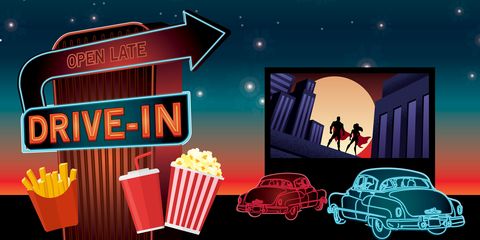
In the early 1930s Richard Hollingshead, a car-parts salesman, had an idea. His mother used to complain about how uncomfortable she found the wooden seats in cinemas. What if she could watch a film from the comfort of her car?
To test the concept in his driveway, he put a film projector on the hood of his car, hung a sheet from some trees and invited his neighbours. He patented the idea and in June 1933 opened his first drive-in cinema – he called it a “park-in theatre” – near Camden, New Jersey. His clever ramp system positioned cars at slightly different heights, to ensure that everyone had a good view of the screen. Tickets cost 25 cents for each person and each car.
His invention, declared Hollingshead, “virtually transforms an ordinary motor car into a private theatre box”. But the idea was slow to take off. By 1945 there were only 96 drive-ins in America. Everything changed in 1949 when Hollingshead’s patent was overturned, allowing other entrepreneurs to open drive-ins without having to pay him royalties. The development of an in-car speaker, which could be clipped to a car window, ensured good sound quality and perfect synchronization with the on-screen image, even for those at the back. The number of drive-ins in America jumped to 2,000 by 1950 and more than 4,000 by 1958.
Hollywood studios saw drive-ins as a threat to their own theatre chains and withheld their best films. For many customers, however, the quality of the film was of secondary importance. Press coverage denounced drive-ins as “passion pits”, which only heightened their popularity. They were also attractive to families, providing a cheap night out without the need for a babysitter, because children could sleep in the car.
Drive-in cinemas went into decline in the late 1950s as shopping malls sprang up in American suburbs. The space occupied by drive-ins was more valuable to property developers as a location for daytime shopping, rather than just showing films in the evening. Besides, more and more people had televisions at home.
The few hundred remaining drive-ins are experiencing an unexpected renaissance in 2020 as social-distancing requirements forced indoor cinemas to close. Some are adding extra screenings, and there are new pop-up drive-ins to meet demand. In a neat reversal of history, 160 Walmart parking lots were turned into temporary drive-ins in USA. Around the world, existing drive-ins and car parks are staging church services, concerts, theatrical performances and, in Germany, even a drive-in nightclub.
The question is whether this new enthusiasm for drive-ins will persist. In many ways, the covid-19 outbreak has propelled us into the future, accelerating the adoption of remote working, online learning, e-commerce and telemedicine. When it comes to drive-ins, however, the pandemic is taking us back to the past.
